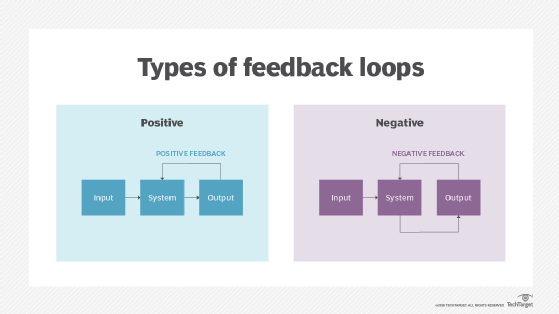feedback loop
A feedback loop is the part of a system in which some portion (or all) of the system's output is used as input for future operations. Each feedback loop has a minimum of four stages. During the first stage, input is created. During the second stage, input is captured and stored. During the third stage, input is analyzed and during the fourth stage, the insight gained from analysis is used to make decisions.
Feedback loops can be either negative or positive. Negative feedback loops are self-regulating and useful for and maintaining an optimal state within specific boundaries. An old-fashioned house thermostat that uses bang bang control to turn a furnace on or off is a classic example of a self-regulating negative feedback loop. When the temperature drops to a predetermined low set point, the thermostat switches the heating system on. When the temperature reaches a predetermined high set point, the thermostat switches the heating system off.
Negative feedback loops are known for being stable, but not especially accurate. For example, in the case of a home thermostat, there can be a fairly wide range of acceptable temperatures that can cause the heating system to have a fairly long response time.
In contrast, positive feedback loops simply repeat actions that have been effective in the past. The intention of a positive feedback loop is to amplify a desired variable and naturally move the system away from its starting state to a desired state. Problems can occur, however, when the positive feedback loop grows exponentially without any checks or balances. In such a scenario, a runaway positive feedback loop can make a system become unstable.

Uses for feedback loops
Feedback loops are an important aspect of closed loop control systems. Feedback loops can be applied to a variety of different fields, including:
- In biology, feedback loops help organisms maintain balance in different life cycles. More specifically, with humans, feedback loops include internal temperature regulation and healing.
- In computer science, a feedback loop refers to an endless loop of instructions that can be given to a computer that has no final step.
- In software development, feedback loops are used on programs to detect potential problems or defects within the code.
- In psychology, professionals study the impact of feedback loops that cause patients to fall into cyclical thinking. An example could be a person’s feelings leading up to an important event. Anxiety or fear may negatively impact the actual event itself whereas confidence might result in the opposite effect.
- In economics, an example of a feedback loop is a company that reinvests sales revenue to generate even more income.
- In customer experience, a customer feedback loop refers to a business strategy where product developers use customer opinion to determine future actions.
- In marketing, social media can be used as a feedback loop to improve marketing techniques. For example, measuring the types of content that have the highest levels of engagement can help marketers know which content to pursue in the future.








